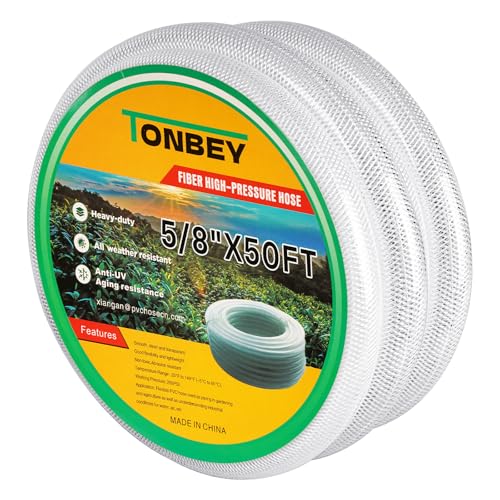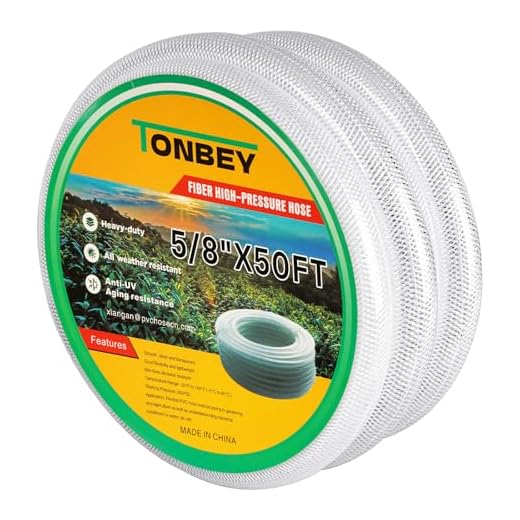
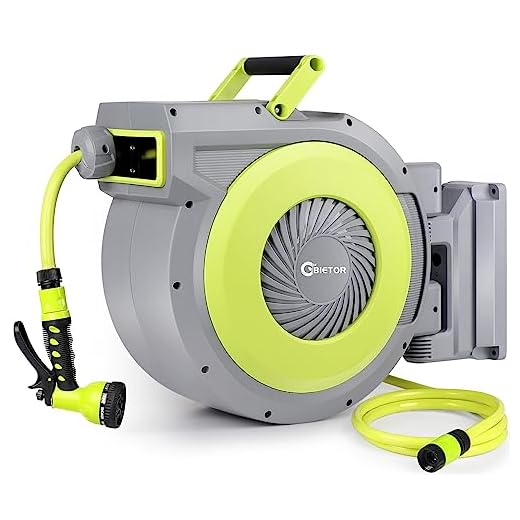


The ideal choice for your cleaning equipment is a high-quality, reinforced hose with a pressure rating that matches or exceeds your device’s output. Opting for a hose made of PVC or rubber will ensure durability and flexibility, essential for manoeuvring during your tasks.
I recommend hoses that are at least 25 feet long, which provides ample reach without the inconvenience of multiple connections. Consider a diameter of 1/4 inch for most domestic cleaning units, but if your machine generates higher flow rates, a 3/8 inch diameter will better accommodate that pressure.
Investing in an appropriate quick-connect fitting will save you time and frustration when attaching and detaching the hose from the pump. It’s beneficial to have a hose with an anti-kink design, reducing tangles and enhancing ease of use during your cleaning sessions.
Remember to always verify compatibility with your specific model, as not every hose will suit all machines. Choosing the right accessories will enhance performance and prolong the life of your cleaning equipment.
Choosing the Right Tubing for Your High-Pressure Equipment
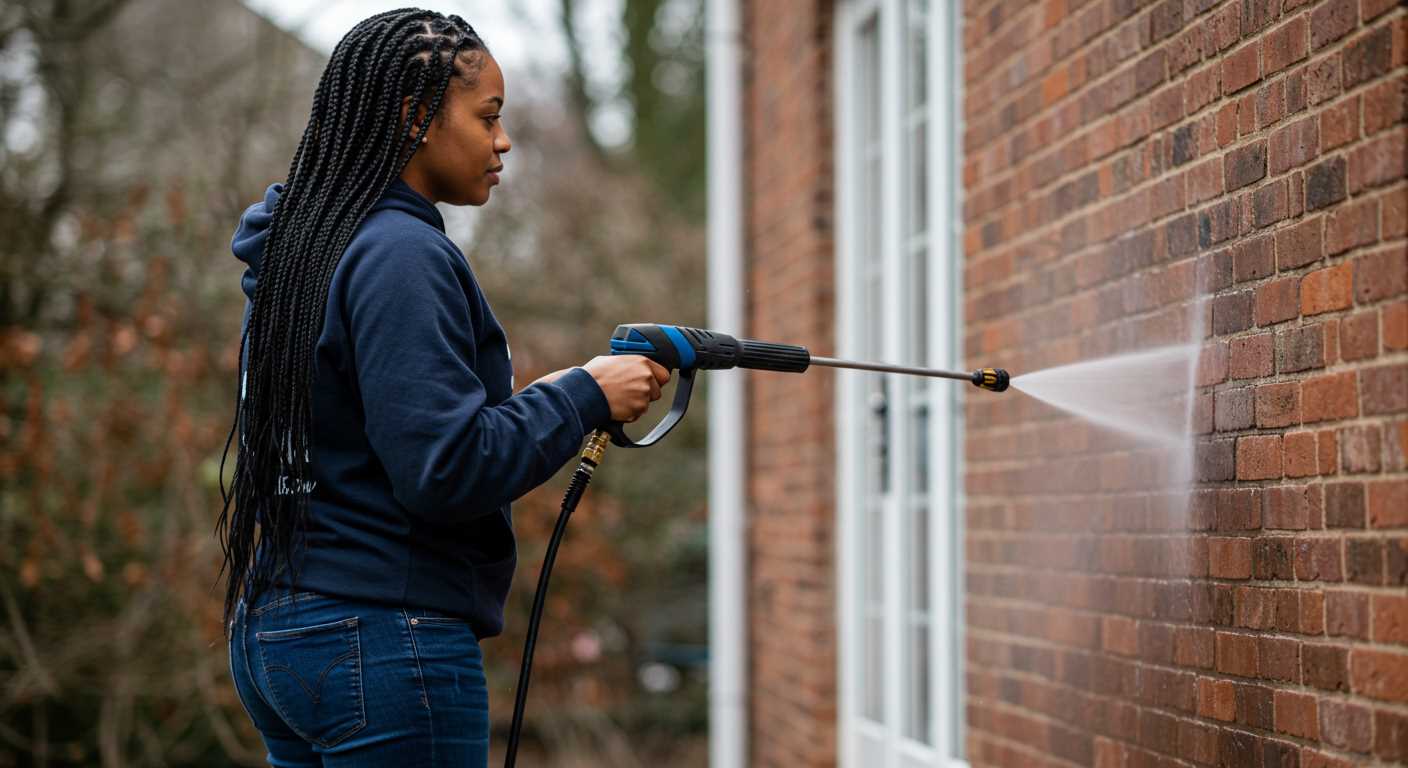
A flexible option with a diameter of 1/4 inch is typically suitable for most high-pressure setups, offering optimal water flow and minimal resistance. It’s crucial to consider the length; I recommend keeping it as short as possible to prevent loss of pressure. For larger projects, a 50 to 100-foot length can be utilised, but ensure it doesn’t exceed the pressure washer’s specifications.
Materials are equally important. Opt for reinforced rubber or PVC that can withstand high pressure and resist kinks. A rubber variant usually provides better durability and flexibility in varying temperatures. Avoid using garden hoses as they lack the necessary pressure tolerance and can lead to leaks and bursts.
Some equipment comes with quick-connect fittings, making it easier to attach or detach the tubing. Always check compatibility with your model to avoid issues. Additionally, consider the temperature rating; most setups function best with cold water, but if using hot water, confirm that the tubing can accommodate those conditions.
Lastly, maintenance is key. Regularly inspect for wear and tear, and store the tubing properly to prevent damage. This will extend the life of your high-pressure system and enhance its performance significantly.
Understanding Pressure Washer Requirements
Choosing the right equipment involves paying attention to the specifications of your cleaning tool and its compatibility with accessories. Most electric models operate at a maximum of 1200 to 2000 PSI, while gas variations can push pressures up to 4000 PSI. Knowing your machine’s rating ensures you select compatible connectors and fittings.
Also, consider the length of the connecting line. Opting for a longer line can provide more mobility but may reduce the water flow efficiency. I recommend using a line that balances reach and pressure loss–typically between 25 to 50 feet works well without excessive drops in performance.
Material matters as well. Rubber hoses generally offer better durability and resistance to kinks compared to plastic options. Look for options designed specifically for high pressure to prevent wear and potential leaks during use.
Moreover, check the fitting types, as most models use either quick-connect or threaded ends. Ensure your selected line matches your machine’s connection style. Adapting with incompatible fittings can lead to disruptions and inefficiency.
Finally, always verify the water flow rate (measured in GPM) required by your tool. The connection must facilitate the correct flow to maintain performance levels. Balancing PSI and GPM is key for optimal cleaning results.
Choosing the Right Hosepipe Diameter
For optimal performance, select a diameter that aligns with the specifications of your equipment. Generally, a diameter of 1/4 inch suits electric models, while 3/8 inch is recommended for gas-powered units. These measurements help achieve the right flow rate and pressure, ensuring effective cleaning without overwhelming the system.
Flow Rate and Compatibility
Consider the flow rate your machine output. A wider diameter allows more water flow, enhancing cleaning efficiency. However, ensure compatibility with both the cleaner and the fittings to prevent leaks or malfunctions. If your model specifies a diameter, adhere strictly to that guideline to maintain performance. Mixing sizes can lead to pressure loss and insufficient cleaning.
Usage Scenarios
For light tasks like cleaning vehicles or patio furniture, a smaller diameter suffices. However, heavy-duty jobs such as siding or concrete cleaning may demand a larger diameter for sustained power delivery. Evaluate your intended uses carefully and select accordingly to balance convenience and performance.
Material Options for Hosepipes: PVC vs Rubber
I recommend opting for a rubber construction for durability and flexibility in demanding tasks. Rubber hoses withstand higher temperatures and pressures compared to PVC variants, making them suitable for commercial applications.
PVC Hosepipes
- Lightweight and easy to handle, which is ideal for residential use.
- More affordable than rubber options, making them budget-friendly.
- Less resistant to temperature fluctuations and may degrade in UV light, leading to cracks over time.
- Typically suited for lower pressure and frequency of use.
Rubber Hosepipes
- Superior resistance to abrasion and punctures, ensuring longevity.
- Retains flexibility in cold weather, preventing kinking and collapsing.
- Higher resistance to heat and can handle greater water flow without damage.
- Often preferred for extended or heavy-duty tasks due to durability.
When selecting between these options, consider the frequency and intensity of your cleaning assignments. If you are using your equipment regularly or for extended periods, investing in rubber is wise for improved performance and lifespan.
Length Considerations for Hose Selection
Choosing the right length is vital for achieving optimal performance. Typically, lengths range from 6 to 15 metres, with longer options affecting water pressure and flow rate. For most residential tasks, a length between 8 to 12 metres works well, allowing adequate reach without excessive pressure loss.
Consider the distance from the source to the area of cleaning. A longer flexible tube can facilitate movement but may reduce the machine’s effectiveness if too long. For heavy-duty or commercial cleaning, lengths up to 15 metres might be suitable, but ensure you have sufficient power to maintain pressure.
Additionally, be cautious about storage. Longer models can be cumbersome, making them difficult to store or transport. Look for options with storage solutions, like reels or hooks, to enhance usability.
Finally, plan for future needs. If expansion is a possibility, invest in a longer variant from the outset. This foresight can save time and money down the line.
| Length (Metres) | Recommended Use |
|---|---|
| 6 | Small tasks around the home |
| 8-12 | General cleaning for residential use |
| 15 | Heavy-duty and commercial cleaning |
Benefits of Reinforced Hosepipes
Reinforced tubes provide significant advantages when selecting attachments for high-pressure cleaning devices. The added layers of reinforced material enhance durability, effectively resisting kinks and abrasions during use. This feature ensures longevity, as regular substitutes may wear out quickly under rigorous conditions.
Another benefit lies in the pressure rating of reinforced models, which can typically withstand greater levels of force. This capacity means users can achieve optimal cleaning results without worrying about blowouts or leaks, enhancing overall efficiency. For heavy-duty tasks or commercial applications, a reinforced design becomes a smart choice.
Flexibility is another key characteristic of these durable attachments. Although they are tough, many reinforced hoses retain good flexibility, making them easier to manipulate around obstacles and tight corners. This blend of sturdiness and maneuverability is particularly advantageous in various cleaning scenarios.
Reinforced products often exhibit resistance to UV rays and temperature fluctuations, making them suitable for both indoor and outdoor use. This characteristic minimizes the risks associated with sun damage or extreme weather, extending the life of the accessory in diverse environments.
Lastly, reliable brands that produce reinforced options frequently include warranties and quality guarantees, offering peace of mind for those investing in these essential components. The combination of strength, resilience, and assurance makes reinforced hoses a preferred option for anyone serious about their cleaning tasks.
Compatibility with Different Pressure Washer Models

Choosing a compatible water delivery line is crucial for optimal performance. Each model of cleaning device has specific requirements regarding connection types, pressure ratings, and hose dimensions. I recommend checking the user manual or manufacturer’s website for compatibility charts tailored to your unit.
Many domestic units operate with quick-connect fittings, while commercial-grade equipment might employ threaded connectors. Ensure the selected line matches your model’s fitting style to avoid leaks. Adapters are available, but relying on them can sometimes reduce efficiency.
It’s vital to match the operational pressure of the line with the specifications of the device. For instance, a model rated at 3000 PSI necessitates a hose capable of handling that pressure without compromising safety. Oversizing or undersizing can lead to reduced performance and potential hazards.
Length impacts usability; however, it should be noted that excessive length can result in pressure loss. Stick to what is necessary while keeping your cleaning range in mind. A reliable choice is to use a line that is 50 to 100 feet, balancing manoeuvrability and performance.
Conducting thorough research on various brands can also uncover lines that are specifically designed for certain models. Some manufacturers, such as Karcher or Nilfisk, offer proprietary hoses that seamlessly integrate with their equipment. Opting for these can enhance compatibility and performance.
Lastly, consider customer feedback on specific lines. User reviews often highlight compatibility issues or successes that can inform your decision, ensuring you choose a hose that will serve you effectively with your particular cleaning equipment.
Maintaining Your Hosepipe for Longevity
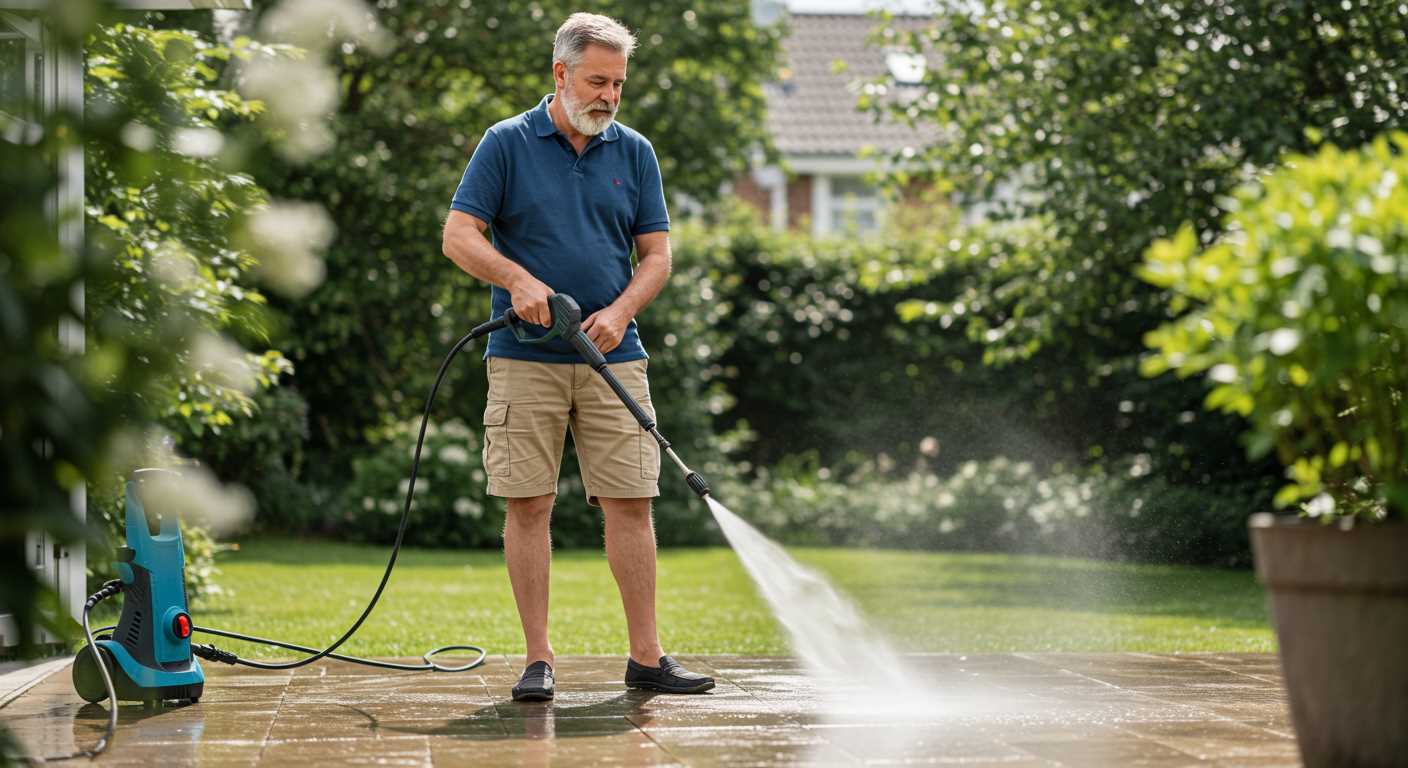
Regular inspection is key. Check for any signs of wear, cracks, or kinks each time you use your equipment. Early detection can prevent significant damage.
Cleaning is vital. Rinse the tubing after each use to remove dirt and residues that can accumulate inside. This helps maintain water quality and prevents blockages.
Coiling the pipe properly after each use extends its lifespan. Avoid sharp bends; lay it flat or coil it loosely to prevent stress on the material.
Storage conditions matter. Keep it in a cool, dry place away from direct sunlight or extreme temperatures. UV rays can degrade materials, especially in PVC variants.
Invest in a quality reel for storage. A proper reel not only keeps the hose organized but also helps prevent tangles and damage during storage.
Check connectors regularly. Ensure they are tight and free from leaks. Replace any worn or damaged fittings to maintain optimal performance.
Consider using a hose protector. A simple foam sleeve at connection points reduces wear from friction when the equipment is in use.
Utilise a filter system if sediment in your water supply is an issue. This protects both your cleaning equipment and hose from potential clogs.
Conduct a seasonal inspection. At least once a year, give everything a thorough check, especially before peak usage times. Replace any damaged components immediately.
Following these steps will ensure your tubing remains in excellent condition, enhancing its durability and your overall cleaning efficiency.
Accessories to Enhance Hosepipe Performance
Investing in quality fittings can significantly improve water flow and pressure consistency. A quick-connect coupling system allows for easy attachment and detachment, which minimises downtime during cleaning tasks. Ensure the fittings are made from durable materials like brass to withstand wear and tear.
Pressure Regulating Valves
Adding a pressure regulating valve is beneficial for maintaining optimal function, preventing potential damage from excessive pressure. This accessory is particularly useful for sensitive surfaces or intricate cleaning tasks, where control is crucial.
Protective Covers and Storage Solutions
Utilising protective covers helps shield the cleaning line from environmental damage, reducing wear caused by UV rays and adverse weather conditions. Additionally, a proper storage solution, such as a reel or holder, keeps the setup organized and prevents kinks or tangles, thus extending the lifespan of your equipment.

